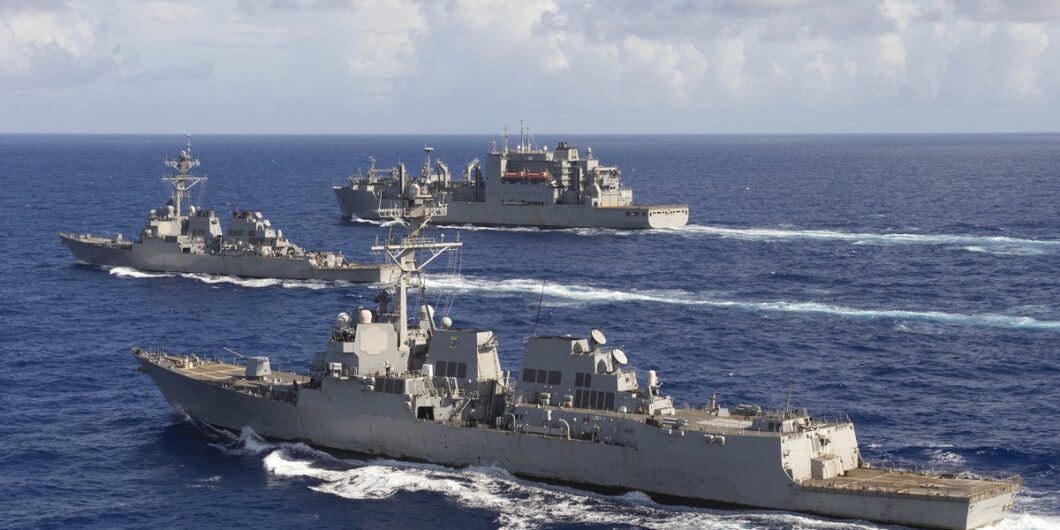The adjustments that AI will demand of our professional and educational institutions first require reflection on what it means to be human.
To Provide and Maintain a Navy
The authority of Congress to “provide and maintain a Navy” is simply and directly stated as one of the enumerated powers of the Legislative Branch of government. The framers of the U.S. Constitution likely little dreamed that Congress would one day use that authority to build and send to sea the most powerful navy in world history—a guarantor of the nation’s sovereignty, prosperity, and peace.
It is no small matter then, to craft a broad strategy to determine the size, capabilities, disposition, and deployment of the United States Navy of the future. Brent D. Sadler, with his new book, U.S. Naval Power in the 21st Century: A New Strategy for Facing the Chinese and Russian Threat, tackles that challenge. Whatever the challenges of this century, however, the mission of the Navy has not changed. It must protect the sea lines of communication vital to global trade, deter aggression, and fight and win the nation’s wars at sea.
Sadler is no stranger to the missions of the Navy. A Navy veteran, retired in the rank of Captain, Sadler pursued a 26-year career with assignments ashore and afloat. He has operational experience in submarine warfare, served on the staff of the Chief of Naval Operations (CNO), and was assigned as a military attaché in Malaysia. Now a senior research fellow at the Heritage Foundation, he focuses his work there on maritime security and future maritime technologies.
Naval Statecraft
Sadler argues the United States has entered a new era of great power competition with China and Russia. “In this global contest, mobility and ability to apply sustained force makes the Navy an asymmetric challenge to Chinese and Russia theories of victory.” To mount this asymmetric challenge, the author proposes a strategy of “naval statecraft” a “synthesis of naval power in a comprehensive strategic competitive framework,” that sees “naval operations conceptualized in a wider diplomatic and economic construct.”
In some ways this is an orthodox approach; the levers of national power have always been military, economic, diplomatic, and informational. Sadler, however, is calling for a global strategy that requires new and broader U.S. commitments to posture (military forward basing and economic investments), presence (regional deployment of military, diplomatic, and government agency personnel), partner capacity building, treaties and agreements, and in the information domain. This is a heavy lift. The Achilles heel of American foreign policy has been the persistent failure to sustain “whole of government” efforts that seamlessly meld policy and practice.
The author also argues that naval statecraft cannot be accomplished unless the Navy can exercise broader operational and administrative control of naval forces, because the “existing architecture … emphasizes individual geographic command’s requirements to the detriment of a coherent global maritime strategy.” At one point, he suggests the Navy “should become a global operational command, not unlike Space or Cyber Commands, providing unique, domain-centered capabilities.” Sadler also argues the Navy should be a “joint functional command responsible for all maritime forces.” The reader is left to puzzle out just what Sadler hopes to achieve with two very different proposals, beyond that of ensuring the Navy has more autonomy.
Sadler’s proposals are ambitious and would likely face stiff headwinds. Institutional resistance to change in the Department of Defense, and in the government, is tenacious. In addition, the author fails to calculate the truly full cost of implementing this bold strategy, both in real and political capital. Regrettably, there is no U.S. Navy Caucus on Capitol Hill.
Strategy and Reality
At the heart of this plan of naval statecraft is the author’s recommendation to grow the Navy from its present 323 ships to 575 ships from 2023 to 2035. The Navy’s own Force Structure Assessment, as briefed to Congress, calls for 355 ships in this same period. But if the heart of the twenty-first-century naval strategy is asymmetrical, as Sadler suggests, then it makes little sense to engage, hull to hull, in a shipbuilding contest with China and Russia. While Russia’s naval industry is the largest hole in its increasingly hollow defense industrial establishment, China is another story. China is the world’s largest shipbuilder; an estimated 47 percent of all new ships are built in China. The United States has neither the shipyards nor the skilled shipyard workers to keep pace with China.
Nonetheless, U.S. Naval Power in the 21st Century argues for increased funding for Navy shipbuilding. “The case,” Sadler writes, “must be made that to reverse trends and grow the Navy, a major recapitalization effort is needed.” The author also argues the pressing need for modernized and enlarged shipyard infrastructure, for training and hiring a new and highly skilled marine workforce, for hiring thousands of new engineers and naval architects, and for rebuilding the U.S. merchant marine. More than a naval strategy, Sadler describes and proposes to launch a “National Maritime Program.”
But it will take years to build new shipyards and decades to recruit, hire, train, and develop an experienced workforce of efficient laborers, ingenious naval architects, and skilled mariners. The reality is these proposals will likely be dead on arrival at Capitol Hill. Given the state of the nation’s budget and its debt, Congress is unlikely to approve more money for the Navy or for a full-blown national maritime effort.
That’s why Sadler is more on point with the asymmetrical strategy he advocates when he calls for “new unmanned or optionally manned platforms that … will reduce operational stress on the manned ships and provide much-needed capacity.” Events in the war in Ukraine have convincingly demonstrated the battlespace utility of cheap, expendable unmanned drones and anti-ship missiles like the Neptune ASMs that sank the Russian cruiser Moskva.
Sadler has charted the right course in his call for greater unmanned capabilities for the Navy, with as much as 24 percent of the fleet of 2035 composed of unmanned vessels. He also has a bold vision of a future fleet armed with energy weapons, crewed by robotics, and enabled by artificial intelligence. But the author does not account for the greater effort that must be made to fund and develop these truly asymmetric capabilities and make them wholly operational in the fleet. This strategy will require the Navy and Congress to make deliberate, calculated trade-offs between legacy platforms and new capabilities.
U.S. Naval Strategy for the 21st Century falls short as a cohesive plan of ends that likely can be achieved with limited ways and means.
Geographic Focus
Sadler writes that naval statecraft and “the Navy’s endeavor to defend the maritime rules-based order requires deploying limited resources prudently, prioritized globally according to risk and opportunity.” He suggests prioritizing maritime regions “key to sustained U.S. prosperity and security” in areas for “advancing favorable legal and diplomatic norms, expanding economic interests, bolstering military alliances,” and “securing operational military necessities (sic. advantage).” To accomplish this, Sadler proposes to realign the current numbered fleets and add an additional, reconstituted First Fleet to create an enduring presence in the South China Sea.
But Sadler’s global posture strategy for the U.S. Navy does not specify a dedicated role for the naval forces of NATO, or for America’s regional allies and partners. For example, the author proposes to assign the U.S. Sixth Fleet to the Eastern Mediterranean for “great power competition activities,” and for contingencies. No mention is made of how to integrate NATO naval forces in the region. The same is true for the Indian Ocean area of operations. Sadler proposes to commit the whole of Fifth Fleet to this area of more than 28 million square miles but makes no mention of a defined role for regional allies Australia and India. There is little more than passing comments and anecdotal remarks about allies and partners in Sadler’s narrative, even though “partner capabilities,” and “treaties and agreements” figure prominently in his design of naval statecraft. This is an oversight, especially as the author has proposed a far-flung global strategy that threatens to stretch the U.S. Navy’s presence well past both its capacity and its capabilities.
There are other flaws in U.S. Naval Power in the 21st Century beyond the gaps in the author’s arguments. Sadler’s writing is sometimes dogged by jargon, awkward construction, tortured syntax, redundancies, and odd word choices—problems a competent editor would have either noted for rewrite or corrected. For example, he writes of “the emergence of a cacophony of more militarily and economically impacting regional powers”; tells the reader “the following list provides a listing”; and that China’s People’s Liberation Army Navy (PLAN) “Admiral Liu geographically explained the goalposts for the PLAN’s development.” There are grating errors in the book, too. For example, Sadler describes the COCOMs Southern Command and Northern Command as South Command and North Command.
The graphics in this book—never referenced in the text—are muddy and cluttered. “Map 5. Other Key Areas of Naval Activity,” is an especially poor jumble of seven geo-political, maritime, geologic, and economic elements most of which are illustrated in almost indistinguishable shades of grey. “Table 3. Planning for the Future: Key Initiatives for the Navy (details)” lists incorrect subheads for categories of initiatives and uses a nearly unreadable greyed-out type font.
For reasons never explained in the text, the book is also illustrated with three photos taken during WWII (credited to a Sadler relative) in the Pacific. Perhaps this is because Sadler repeatedly turns to the U.S. Navy of WWII for examples of the penultimate naval force. The author’s “Fleet Design 2035” calls for the addition of escort aircraft carriers and small carriers for convoy duty and anti-submarine operations—both functions of the small deck “jeep” carriers of WWII. He proposes that Seabees (Naval Mobile Construction Battalions) now stationed on Guam continue to be deployed to Pacific Islands to renovate “legacy military infrastructure,” from WWII in places “like Yap, Pohnpei, and Chuuk (previously Truk) Lagoon” with “outdated but perhaps once again useful ammunition bunkers, airfields, and ports.” He argues that forward-deployed repair ships should operate with the fleet, a lesson “learned … during World War II … should not have to be repeated in a present-day conflict.”
Sadler apparently believes a naval war in the Pacific, ostensibly between the U.S. and China, would be a protracted war of attrition. This belief underpins much of Sadler’s argument and, thereby, justifies a strategy for a force structure that will take more than a decade to build, man, train, and send to sea. The author, however, fails to explain why America’s adversaries in the Pacific would forego their plans during the decade in which the U.S. Navy grew in strength. The reality is Beijing probably realizes—especially as it views the war in Ukraine—that a military invasion of Taiwan must be short and decisive, or it should not be undertaken at all. A long war in the Pacific would be a strategic defeat for China, even if China were to achieve a tactical victory with a successful invasion and occupation of Taiwan.
U.S. Naval Strategy for the 21st Century lives up to its title—it is a strategy. But it falls short as a cohesive plan of ends that likely can be achieved with limited ways and means. As a starting point for an informed discussion, Sadler’s book could promote a renewed and healthy debate. This is a debate that would inform a feckless Congress about funding the capabilities and capacity of a future U.S. Navy that will secure the national interest—and fulfill the challenging requirements of its enduring mission.


